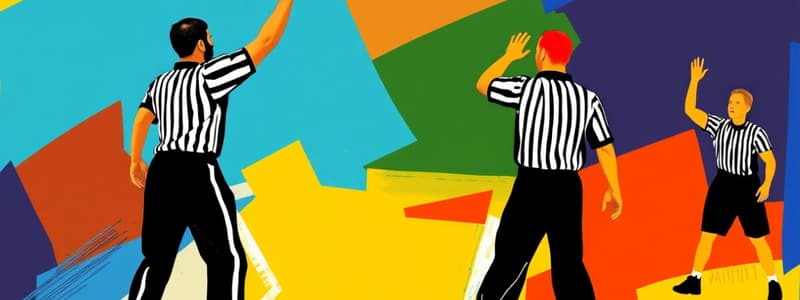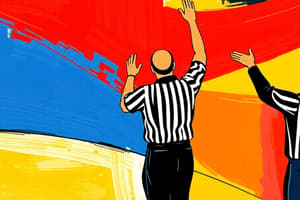Podcast
Questions and Answers
What does 'start clock' refer to?
What does 'start clock' refer to?
- Signal for a foul
- Signal for a timeout
- Signal to stop the game clock
- Signal to begin the game clock (correct)
What does 'stop clock' mean?
What does 'stop clock' mean?
- Signal for a player foul
- Signal to pause the game clock (correct)
- Signal to end the game
- Signal for a team's timeout
When do referees use the 'stop clock for jump/held ball' signal?
When do referees use the 'stop clock for jump/held ball' signal?
- To signal a timeout
- To indicate a foul
- When the ball is out of bounds
- When players are tied up and a jump ball is called (correct)
What does the 'stop clock for foul' signal indicate?
What does the 'stop clock for foul' signal indicate?
What does a '60-second time-out' signal look like?
What does a '60-second time-out' signal look like?
What denotes a '30-second time-out'?
What denotes a '30-second time-out'?
What does the signal for 'not closely guarded' look like?
What does the signal for 'not closely guarded' look like?
How is 'traveling' indicated by referees?
How is 'traveling' indicated by referees?
What does the 'player-control foul' signal indicate?
What does the 'player-control foul' signal indicate?
What does 'blocking' look like for referees?
What does 'blocking' look like for referees?
Flashcards
Start Clock
Start Clock
Signal to begin the game clock.
Stop Clock
Stop Clock
Signal to pause the game clock.
Stop Clock (Jump/Held Ball)
Stop Clock (Jump/Held Ball)
Halts the clock for a jump ball or held ball situation.
Stop Clock (Foul)
Stop Clock (Foul)
Signup and view all the flashcards
Directional Signal
Directional Signal
Signup and view all the flashcards
Designated Spot
Designated Spot
Signup and view all the flashcards
Visible Courts
Visible Courts
Signup and view all the flashcards
Beckoning Substitutes
Beckoning Substitutes
Signup and view all the flashcards
60-second Time-out
60-second Time-out
Signup and view all the flashcards
30-second Time-out
30-second Time-out
Signup and view all the flashcards
Not Closely Guarded
Not Closely Guarded
Signup and view all the flashcards
Illegal Dribble
Illegal Dribble
Signup and view all the flashcards
Goal Counts
Goal Counts
Signup and view all the flashcards
3 Point Field Goal
3 Point Field Goal
Signup and view all the flashcards
Bonus Free Throw for 2nd Throw
Bonus Free Throw for 2nd Throw
Signup and view all the flashcards
Delayed Lane Violation
Delayed Lane Violation
Signup and view all the flashcards
Traveling
Traveling
Signup and view all the flashcards
Palming/Carrying
Palming/Carrying
Signup and view all the flashcards
Over and Back
Over and Back
Signup and view all the flashcards
Point(s) Scored
Point(s) Scored
Signup and view all the flashcards
3-Second Violation
3-Second Violation
Signup and view all the flashcards
5-Second Violation
5-Second Violation
Signup and view all the flashcards
10-Second Violation
10-Second Violation
Signup and view all the flashcards
Study Notes
Basketball Referee Signals
- Start Clock: Signal to begin timing the game.
- Stop Clock: Indication to halt the game clock.
- Stop Clock for Jump/Held Ball: Signal used when a jump ball or held ball situation arises.
- Stop Clock for Foul: A signal to pause the clock due to a foul call.
- Stop Clock for Foul (Optional Bird Dog): Similar to other foul signals; may include assistance from another official.
- Directional Signal: Refers to a check sheet for indicating the direction of play or violation.
- Designated Spot: Reference the specific area on the court for free throws or throw-ins.
- Visible Courts: A method for signaling that includes moving a hand back and forth, checked against a reference sheet.
- Beckoning Substitutes: A signal to indicate to players that substitutions are allowed.
- 60-second Time-out: Hands extended and folded back in a repeating motion to signal a full time-out.
- 30-second Time-out: Hands touching shoulders to signal a shorter time-out.
- Not Closely Guarded: Hands extended out to signal that a player is not being closely guarded.
- No Score: Utilizes a check sheet for signaling that a shot was not successful.
- Goal Counts: Signal indicating that the shot successfully counts towards the score.
- Point(s) Scored: Use of one or two fingers to indicate the number of points scored after confirming a goal.
- 3 Point Field Goal Attempt: Signal for indicating attempts and outcomes of three-point shots.
- Bonus Free Throw for 2nd Throw: Varies the signal based on number of attempts indicated (e.g., drop one arm for two throws).
- Delayed Lane Violation: A signal indicating a violation occurring in the lane, typically held until ready to call.
- Traveling: A signal executed by moving hands in a circular fist motion.
- Illegal Dribble: Indicates a violation related to improper dribbling actions.
- Palming/Carrying the Ball: Signal for illegal handling of the basketball.
- Over and Back: A situation where the ball crosses back into the backcourt after being in the frontcourt.
- 3-Second Violation: Signal involves running an open hand along the baseline.
- 5-Second Violation: Indicates that a player has exceeded the allowed time to make a particular play.
- 10-Second Violation: A signal indicating that the team failed to advance the ball past half court.
- Excessively Swinging Arm(s)/Elbow(s): A signal for a foul involving unnecessary contact with limbs.
- Kicking: Signaled by mimicking a leg kicking motion.
- Illegal Use of Hand: Indicates a foul that involves improper usage of hands.
- Hand Check: Involves signaling a foul for overly aggressive use of hands to impede progress.
- Holding: A signal where one hand is held at the wrist while the other forms a fist.
- Blocking: Hands placed on hips to indicate a blocking foul.
- Pushing: Two hands placed in front of the referee to signal a push foul.
- Player-Control Foul: A foul called against the player in possession of the ball.
- Team-Control Foul: A foul committed by the team when they are in possession, impacting play.
- Intentional Foul: A deliberate foul to disrupt the opposing team’s play.
- Double Foul: A foul called on two opposing players simultaneously.
- Technical Foul: A violation of game conduct, often resulting in free throws for the opposing team.
Studying That Suits You
Use AI to generate personalized quizzes and flashcards to suit your learning preferences.




